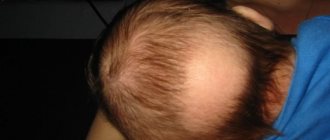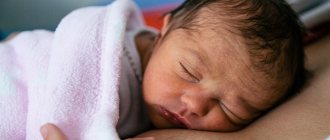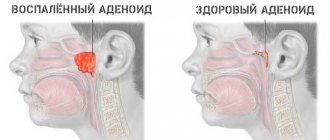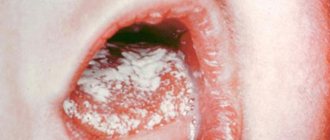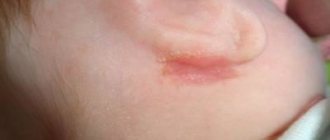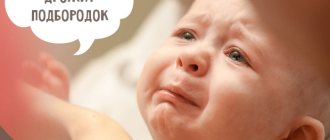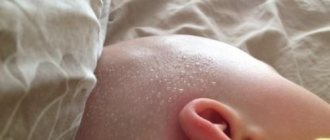Causes of cold hands
Young parents are often concerned with the question of why their baby has cold hands. This problem may be associated with the physiological characteristics of the newborn’s development, some disease, or external factors depending on the air temperature.
- Formation of the vegetative system. The baby's body gradually gets used to the environment, its various systems develop slowly, and the heat exchange process is formed by about 1.5 years of age. Therefore, cold hands in a baby are normal and are due to its physiological development.
- The occurrence of the disease. The child’s body can send signals to the mother that something is wrong with it, so in addition to the hands, it is necessary to pay attention to the condition of the newborn as a whole. He may develop symptoms such as prolonged crying for no reason, skin rashes, loss of appetite, indigestion, high or low temperature. If these signs are detected, it is necessary to show the baby to a pediatric doctor.
- Room temperature. If the air in the room is warmed up by less than 20 degrees Celsius, then cold hands on a baby may be a symptom that the newborn has frozen. Pediatricians recommend the following method to help find out whether a child is cold or not: to do this, you need to touch the baby’s chest with the back of your hand. If it is warm, then everything is fine, but if it is cool, then the baby is freezing.
The importance of thermoregulation and circulation in newborns
When asked why a baby at a normal temperature has cold hands and feet, Dr. Komarovsky replies: “There’s nothing wrong with that, it’s a physiological feature of a newborn.” When a baby is born, his body begins to adapt to the world around him, and thermoregulation mechanisms are gradually rebuilt. This is what causes the skin to cool.
In newborns who are not yet a month old, the following phenomena are often observed:
- bluish color of feet and palms;
- skin that is cool (but not icy) to the touch;
- excessive sweating if the room is hot.
These phenomena gradually disappear without requiring treatment, as the child’s body adapts to the characteristics of the environment. Therefore, if you notice a bluish color to your baby’s feet, you should not worry - this happens to almost all children. As the child grows up and begins to move more actively, thermoregulation improves.
Overheating a child is very harmful
Diseases that are symptomatic of cold hands
When a baby’s hands are cold, this may be a sign of some disease, but you need to look at the baby’s general condition; if it is unsatisfactory, it is recommended to consult a pediatrician. Among the ailments are the following:
- infectious and viral diseases, which are also accompanied by cough, runny nose, gastrointestinal upset, rash on the baby’s face and body;
- lack of vitamins and minerals in the newborn’s body;
- iron deficiency, which leads to anemia of the limbs;
- improper functioning of the thyroid gland, characterized by constant constipation, temperature disturbances, and thickening of the tongue.
Why do babies have cold hands and feet?
Enlarged lymph nodes in a child’s neck - causes of inflammation
Even in the maternity hospital, young mothers often ask the doctor why the baby has cold hands or feet. Some doctors insist that newborns need to be wrapped in several diapers, and the temperature in the room must be maintained as high as possible. This is why in many maternity hospitals the wards are very hot and stuffy. In fact, you can't do that.
For your information. Modern pediatricians consider this attitude towards infants wrong. In most cases, cold extremities will not harm the child, but overheating can cause heatstroke.
The list of the most common causes of cold skin in children under one month old includes:
- physiology;
- hypothermia while walking;
- low house temperature if central heating is turned off;
- some diseases.
The first three reasons, caused by external factors, do not require seeing a doctor. This is the age norm.
Attention! Cold extremities occur with elevated body temperature. In this case, the child will be lethargic or, conversely, restless and excited.
If the baby is healthy and cheerful, there is no need to be afraid of cold extremities
Physiological reasons
The physiological reason is undeveloped thermoregulation. Therefore, babies up to a month old may have a slight rise in temperature in the absence of any diseases. This is an age-related phenomenon, it will pass quickly.
Most often, the causes of cold skin to the touch are physiological.
External
External causes of cool skin are not related to the child’s body. They are caused by environmental influences on the baby. For example, a slightly reduced water temperature during swimming can lead to a slight blueness of the extremities and their cooling. There is no need to be afraid of this - hardening plays an important role in the hygiene and development of the baby.
The most common external cause of cold extremities is low room temperature. In this case, you should put another blouse on your baby and socks on his feet. When the baby's skin warms up, they can be removed.
Cold and damp extremities if the house is warm
It happens that the house is warm and even hot, but the child’s skin is cool and moist. This happens quite often with children who were born prematurely, as well as with infants who have congenital malformations. In this case, a consultation with a pediatrician is required to eliminate the problem.
The list of the most common causes of pathological thermoregulation disorders includes:
- circulatory disorders;
- congenital heart defects;
- tuberculosis.
A timely visit to the pediatrician will help parents identify the cause of cold skin and constant excessive sweating. The doctor will prescribe the necessary diagnostic measures and make a conclusion based on the research results.
Pathological causes
The pathological causes of thermoregulation disorders described above pose a great danger to the further development of the baby. Therefore, if a doctor has diagnosed a child with a disease that causes sweating and cooling of the extremities, parents must follow all his instructions until the baby recovers completely.
Improving baby's blood circulation
Young mothers very often wrap their newborn up excessively, they are afraid that he is cold. However, this behavior can negatively affect the development of the newborn’s autonomic system. For its proper formation, it is necessary to carry out the following measures that will improve blood circulation in the body and get rid of the problem of cold hands:
- Massage strengthens and develops the child’s muscles, improves heat exchange processes, and promotes the development of immunity. It is recommended to carry out the massage with light, stroking and rubbing movements with your hands or a special mitten.
- Contrasting water procedures - it is recommended to bathe the baby in warm water, and at the end of the bath, pour water over him from a ladle, the temperature of which is 1-2 degrees lower, but not cold.
- It is recommended to rub the child’s arms and legs after bathing with a rough towel until the color is pink and the body is soft.
Possible diseases
Hyperhidrosis as a symptom has several dangerous diseases that affect internal organs or body systems. It is worth considering that any of the listed pathologies should be treated in the early stages, otherwise it can cause the development of dangerous complications. So, why do feet sweat: pathological reasons.
If there is a suspicion of the development of any of the listed diseases, the baby should be shown to a doctor.
To facilitate the body’s adaptation to the environment or to help it overcome developing pathology, the baby must be carefully monitored. The baby must be dressed in clothes made only from natural materials, and also use cotton bedding. The room where the child lives must be ventilated for at least half an hour every day.
If your baby's feet and hands are sweaty, he should be bathed every day. It is allowed to add a decoction made from string, oak bark or chamomile to the bath. If the problem occurs in a several-month-old baby who is breastfed, the mother should give up fatty foods, salty, spicy and spicy foods. Such preventive measures will allow you to quickly cope with the problem that has arisen and make the first months of his life easier for the baby.
We will talk about a problem that plagues both the children concerned and their parents, namely, excessive sweating (hyperhidrosis) on the feet.
If the sweating is too intense, you need to contact your pediatrician, who will refer you for an examination and find out the cause of the disorder!
Some believe that this occurs only in adults, especially men. But, unfortunately, this is far from the case.
Which age groups are most often susceptible to profuse sweating:
- infants - usually sweating of the feet is independent, if it is not caused by any disease;
- preschoolers;
- teenagers during puberty.
It is still unknown why some children sweat a lot and others do not.
Sweating helps maintain a constant body temperature and prevents overheating. There are a huge number of sweat glands on the soles of the feet.
WHY DO YOUR CHILD'S FEET FREEZE?
The topic of cold children's feet is one of the most discussed among mothers and especially grandmothers. You, too, have probably wondered more than once: “Why does the child have ice-cold feet?” For an answer to this question, we decided to contact a specialist directly. It turned out that not everything is so simple, and cold feet are not necessarily an indicator that the baby is cold. This is what Natalya Kholodnova, a pediatrician and neonatologist, told us.
Why are children's hands and feet often colder than the rest of their body? — Cold limbs can be in three states: 1. the baby is cold, 2. the child has microvascular disorders, 3. everything is fine. The task of parents is to understand which of the three states their baby is in and act in accordance with this.
That is, icy palms and feet can be in their normal state? — There are warm- and cold-loving people. Depending on this, some may walk around with ice-cold feet and still feel comfortable, while others will begin to pull on woolen socks and wrap themselves in a blanket. It is important to determine what type your baby is and evaluate his reaction. If a child begins to be capricious during a walk, fidget, whine, or feel uncomfortable, then you should pay attention to the temperature of the feet and try to insulate and warm the child. Your baby may actually be cold.*
What microvascular disorders can cause cold hands and feet in a child? — The most common are vegetative-vascular dystonia and microvascular disorders with increased body temperature (“white” fever). With vegetative-vascular dystonia, you need to focus only on the child’s well-being and act in the same way as if the baby is frozen. If your baby has a high temperature and at the same time cold legs and arms, this is a serious symptom! Use dry heat (no rubbing!!!!) - only socks, a blanket, a blanket, a heating pad, etc., and also immediately give antipyretics. And if your child is under 3 years old, and such a situation occurs, then you should call an ambulance.
How do you recommend dressing your baby for a walk to make sure his feet don’t get cold? — Usually mothers are very worried about their children’s feet in winter. And rightly so, because they are the ones who freeze most often. First of all, your feet should not be blown out. To do this, you need to use an envelope or a warm cape in the stroller. But even their presence does not eliminate the need for shoes! Winter booties are suitable for infants - down, fur, felt, etc. And if your child is already stomping on his own, then choose the right shoes! *Note by Leokid: Find out how to dress your baby for a walk depending on the weather here.
Causes of wet feet in older children
If parents of 2-3-year-old children go to the doctor with complaints about their children’s constantly wet feet, then rickets can be suspected.
Sweating is not the only symptom of this disease, so in itself it does not indicate vitamin D deficiency.
The diagnosis is confirmed only if there is a combination of certain signs and on the basis of laboratory tests.
If children only have wet feet and there are no other health problems, in all likelihood there is no need to worry too much.
Most likely, this indicates an individual characteristic, often inherited.
Another reason is the following:
- the child is simply hot;
- his shoes are of poor quality;
- their socks are synthetic.
Children themselves are very active, and because of this, their feet become wet. But sweating can be annoying if the baby is sleeping. Fortunately, this rarely happens.
Physical activity increases the process of heat generation and, accordingly, increases the process of sweating. Thanks to this, the body cools down.
You shouldn’t limit your children’s movements; it’s better to worry about the comfort of their legs!!!
It is likely that doctors of various profiles will be involved in establishing the cause. This must be done if sweating feet in children is accompanied by:
- sleep disturbance;
- increased body temperature;
- fatigue;
- loss of appetite;
- nervousness;
- digestive system disorders;
- skin rashes, etc.
Why do babies' feet sweat?
Intrauterine development of the fetus occurs at a constant temperature. After birth, environmental conditions change.
In the vast majority of cases, sweating before the age of one year occurs due to the immaturity of the thermoregulation system.
This mechanism does not function as clearly in them as in adults, which provokes similar disorders.
Infants are sensitive to temperature changes - their bodies easily become hypothermic and overheated.
For them, sweating is a necessary mechanism that allows them to quickly remove excess heat energy.
The formation of the thermoregulatory system occurs over several years. In most cases, by the end of 1 year, sweating decreases significantly!
Increased muscle tone of the upper and lower extremities is often observed in babies up to 3-6 months. This manifests itself in clenched fists, bent legs, walking on tiptoe, etc.
Muscle tension contributes to increased sweating of the hands and feet in a child. In such cases, soothing baths, special massages, physiotherapy, vitamin-amino acid preparations, etc. help.

